This is an excerpt from my “Global Certifications for Makers & Hardware Startups” eBook. It was contributed by Dr. Vincent Crabree of Starfish Medical, a highly regarded medical device design consultancy.
In almost all jurisdictions around the world, the development and sale of medical devices is controlled by some combination of laws, regulations and standards. All of these national and regional regulatory processes are based on the need to prove the device is safe, effective and properly labeled before allowing the sale and distribution of the device.
Most jurisdictions classify devices according to the risk posed to the patient. The regulatory requirements range from minimal for the lowest risk devices to comprehensive in the case of implantable and life support devices. While most jurisdictions do not mandate a process for proving safety, the most common approach involves testing a sample device against accepted standards or guidelines for electrical and mechanical safety (IEC-60601-1), electromagnetic compliance (IEC-60601-1-2) and biocompatibility (ISO-10993-1).
A clear statement of the intended use, i.e. the disease, condition or abnormality the device is intended to detect, diagnose or treat is required to allow a determination of the effectiveness. To prove effectiveness some combination of bench testing to prove performance equivalent with existing proven devices, animal testing and clinical testing is required.
Labeling requirements differ depending on the jurisdiction, but all require the labeling, which includes instructions for use and training materials, be adequate to allow the safe and effective use of the device.
There is a requirement for a ‘quality system’ to ensure all subsequent devices meet these same standards is also common to all jurisdictions. In the case of medium to high risk devices the quality system is also required to provide evidence that the design and development process addressed both risk management (ISO-14971) and usability (IEC-62366).
As an example consider the requirements for a medium risk device in Canada, the EU and the USA.
Health Canada controls the distribution of medical devices by the granting of a device license once all of the requirements for safety and effectiveness have been met. In the case of a medium risk device this involves testing to accepted standards and some form of effectiveness testing. As well evidence of a quality system certified to ISO 13485 and the requirements of the Canadian Medical Device Regulations is required as part of the submission.
Similar to a consumer device, application of the CE mark is required to distribute a medical device in the EU. For a medium risk device this differs from consumer products in that a 3rd party is required to certify that all the requirements of the Medical Device Directive have been met before the CE mark is applied. This involves preparation of a technical file, including testing to applicable standards, and evidence a quality system meeting the requirements of the Medical Device Directive is in place.
The FDA grants clearance to distribute a device once safety and effectiveness is proven. In the case of a medium risk device this involves proving equivalent performance to a previously cleared device. The proof of safety generally involves testing to accepted standards.
A quality system meeting the requirements of CFR Part 820 is required before distribution can begin.
In all cases testing the device to accepted standards is part of the regulatory process. In most cases the trend towards globalization has resulted in standards that are accepted around the world with only minimal differences to account for local conditions such as supply voltages.
If in doubt, it’s well worth your time consulting with a medical device development consultancy such as Starfish Medical to map the correct path to market.


